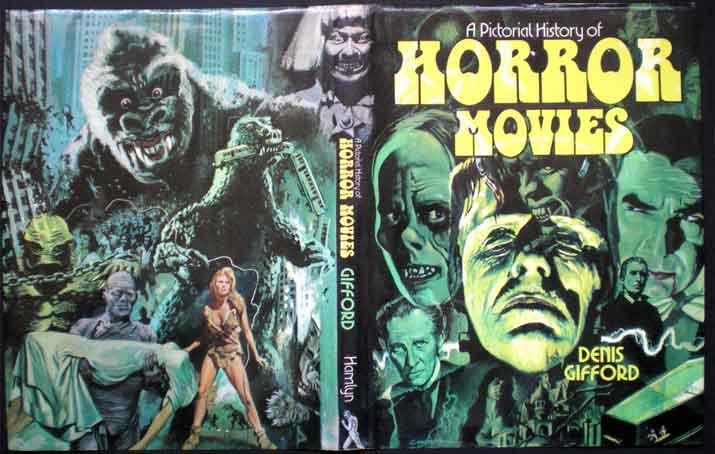ERIC MCNAUGHTON describes the joy he felt as a child first getting his hands on Denis Gifford’s Pictorial History of Horror Movies

It was on a summer holiday in 1973 that I first encountered Denis Gifford’s Pictorial History of Horror Movies.
I was 12 years old and on the family holiday on the Isle of Wight.
I had saved up my pocket money over the preceding months in my very own Post Office Savings account and had the princely sum of £2.50!
We were walking through the local town when suddenly I saw it!
Staring out at me from a bookshop window was a lurid green cover showing an assortment of monsters, most prominently the Frankenstein monster.
Of course I had to have it!
And against my mum’s protestations I shelled out 1.99 and thus began my lifelong love of horror films.
The great strength of Gifford’s book was (and still is) the hundreds of photos (it was a Pictorial History after all).
Page after page of photos from the most fantastic looking films. never did I imagine that one day I would own many of them on DVD to be watched at my leisure.
Looking back as an adult I can see that Gifford gave the Hammers a really hard time, he obviously didn’t like them at all.
I must have read that book dozens of times as a teenager, learning the most amazing facts, not just about the films but the people who made them, the actors and makeup men and directors.
It was in those pages that I was first introduced to the great Lon Chaney, Man of a Thousand Faces, to the mighty Kong, to giant bugs of all shapes and sizes and to a plethora of mad scientists and their deformed assistants.
It was also the first time I had ever seen pics from the Hammer films.
Looking back as an adult I can see that Gifford gave the Hammers a really hard time, he obviously didn’t like them at all.
But you have to remember he was writing at a time when Hammer, Amicus et al were the current wave of horror cinema and not the classic films of yesteryear that we view them as now.
But, as I’ve said, it was the amazing photos that made the book. Even to this day when I watch films I have “Gifford” moments when I recognise a certain scene from the book.
I recently got a DVD copy of Phantom of Soho – a German Edgar Wallace crime from the 60s – purely to see the scene of a glowing skeleton face that had so impressed me in Gifford’s book 40 years ago!
And now my aim is to see each and every fantastic film that is illustrated in A Pictorial History of the Horror Movies!
And that cover still evokes memories like no other book cover can.
I regularly post the imagine on my We Belong Dead group and it never fails to elicit a huge response from members who love it just as much as me.
Despite its flaws, for me it will always be the essential book on horror films and whenever I flick through my copy (the fifth one I’ve owned) I am transported back to a time when I was a 12 year old seeing a world full of wonder and imagination for the very first time.
ERIC McNAUGHTON fell in love with horror films when he got Dennis Gifford’s “Pictorial History of Horror Movies” for his 10th birthday. In the mid 90s he produced “We Belong Dead”, a zine for all lovers of the classic age of horror, which ran for 8 issues. Eric runs the We Belong Dead group on Facebook.


I purchased a much-revered copy whilst on holiday on the Isle of Wight myself! This was from a second-hand book shop when I was about 17.
I think everyone has their own story about how they got their copy of this book 🙂 I’ve had several copies over the years!
I always preferred the books by Alan G. Frank and David Pirie to Gifford. Other than his noble championing of Tod Slaughter, I find Gifford to have had some pretty ridiculous and often hypocritical opinions that meant he’d judge Hammer unfairly for things studios he preferred did also. He claims that Hammer were derivative but ignores the fact that Universal (who I also love) were by the same logic; most of their films were either based on British novels or were sequels that rarely strayed from the format of the original.